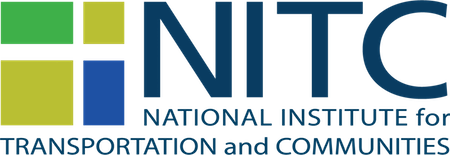View the presentation slides here.
This project builds on the success of NITC’s first Pooled Fund project that created the first national...
Read moreView the presentation slides here.
This project builds on the success of NITC’s first Pooled Fund project that created the first national...
Read moreRoom 204 of the Distance Learning Center Wing of the Urban Center on the Portland State University campus
Abstract: A variety of types of electric bicycles are now available to consumers in America and around the world. While there has been strong uptake of these vehicles in China, there remains uncertainty in other markets about their ultimate potential as a transportation mode. The technology is evolving in ways that are likely to better meet traveller's needs and the growth of this mode presents both opportunities and challenges. Since they have implications for transportation policy, planning and operations it is appropriate for the transportation profession to consider these vehicles carefully. This seminar will review developments and emerging issues with this form of transportation technology.
View slides
Strong and Fearless | Enthused and Confident | Interested but Concerned | No Way No How
Originally developed by Roger Geller for the city of Portland, the “Four Types of Cyclists” typology (Strong and Fearless; Enthused and Confident; Interested but Concerned; No Way No How) has been adopted widely to help guide efforts to increase bicycling for transportation. This webinar will present findings from a new, national survey conducted in collaboration with the National Association of Realtors. In Portland, 60 % of the population falls into the "interested but concerned" category, and they represent a promising segment of the population in terms of increasing the bicycle mode share. In this webinar, we will address the following questions:
Watch video
View slides
The overall goal of this research was to quantify the safety performance of alternative traffic control strategies to mitigate right-turning-vehicle/bicycle collisions, often called "right-hook" crashes, at signalized intersections in Oregon.
A two stage experiment was developed in the OSU high-fidelity driving simulator to investigate the causal factors of right-hook crashes at signalized intersections with a striped bike lane and no right-turn lane, and to then identify and evaluate alternative design treatments that could mitigate the occurrence of right-hook crashes.
Experiment 1 investigated motorist and environmental related causal factors of right-hook crashes, using three different motorist performance measures:
Data was collected from 51 participants (30 male and 21 female) turning right 820 times in 21 different experimental scenarios. It was determined that the worst case right-hook scenario occurred when a bicycle was approaching the intersection at a higher speed (16 mph) and positioned in the blind zone of the motorist. In crash and near crash situations (measured by time-to-collision) the most common cause was a...
Read moreThe video begins at 3:55.
View slides
Abstract: Portland is planning to launch a bike share system. Bike share is a new form of public transit that is rapidly spreading through the United States. In 2009, bike share operated in two U.S. cities. Today, 20 US cities operate systems with another 15 in the planning stages. In several cities, including Denver, Minneapolis and Washington, DC bike share has demonstrated the ability to bring new people to bicycling while reducing single occupancy vehicle trips. How will bike share work in the nation’s most bike friendly city (doesn’t everybody already have a bike)? What challenges does Portland face, and what opportunities does bike share offer to reach the Portland’s Bike Plan for 2030’s ambitious goals?
Speaker Bio: Steve Hoyt-McBeth is a project manager in the Portland Bureau of Transportation’s Active Transportation Division. He has worked on bike share at PBOT since 2008. Steve also manages PBOT’s employer and commuter Transportation Demand Management program, SmartTrips Business. He has 15 years experience working with local governments and neighborhoods in Oregon and California on land use, energy and transportation issues. Steve is a graduate of the University of Oregon.
LOCATION: PSU, Urban Center Building, Room 204 (Distance Learning Center Wing)
LIVESTREAM ONLINE: Click here on the day of the seminar to stream it live
SEMINAR VIDEO
This presentation will begin with an overview of the activities of the Centre for Accident Research and Road Safety-Queensland. Then a number of bicycle safety research projects...
Read moreThe video begins at 3:15.
In 2005, Davis, California was the first city in the U.S. to be named a Platinum-level Bicycle Friendly Community by the League of American Bicyclists. Although Davis has long been held up as a model bicycling community, where residents bike as a normal part of their daily lives, it has not been rigorously studied. Several studies underway at UC Davis are helping to fill this gap: an analysis of the history of bicycling policy in Davis; a behavioral study of factors contributing to high levels of bicycling in Davis in comparison; and an evaluation of a recent campaign to get kids to bicycle to soccer games. This presentation offers highlights from a three studies to provide a critical assessment of Davis as a bicycling community.
Susan Handy is a professor in the Department of Environmental Science and Policy and the director of the Sustainable Transportation Center at the University of California Davis. Her research focuses on the connections between land use and transportation, and she is well known for her work on the impact of neighborhood design on travel behavior. She serves on three committees of the Transportation Research Board and on the editorial boards of several journals in the fields of planning, transportation, and public health.
View slides
Watch video:
Some researchers have tried to categorize cyclists’ levels of traffic stress utilizing facility or traffic data that can be readily measured in the field, such as motorized travel lanes, travel speeds, and type of bicycle infrastructure.
This seminar will present data and modeling results utilizing two novel data sources:
(a) real-world, on-road measurements of physiological stress as cyclists...
Read more